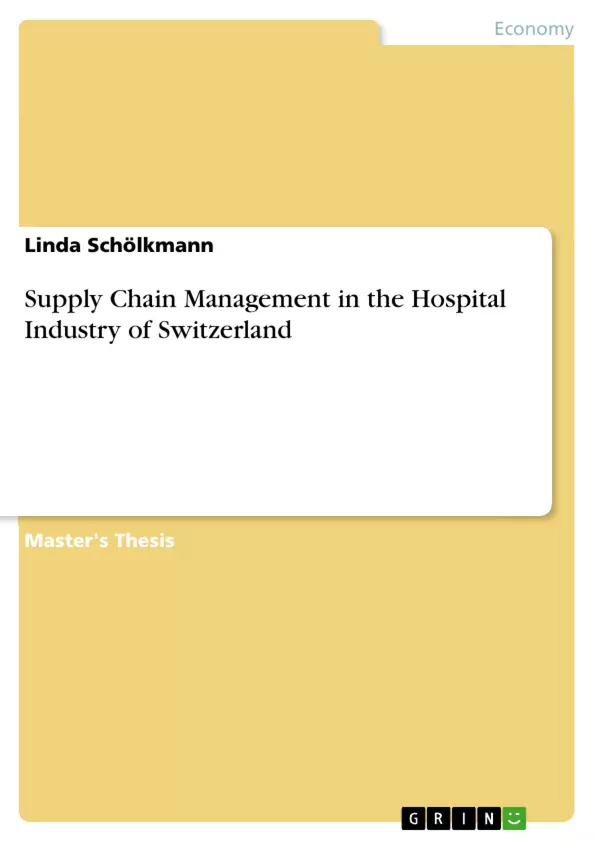This dissertation seeks to investigate how the Swiss hospital industry can face the upcoming budgeting restrictions set by the Swiss government. Following an analysis of the political and economic environment of the industry the paper focuses on hospitals‟ material management, demonstrating that this is an area with substantial savings potentials.
At first the study examines the industrial approach of supply chain management (SCM) as a way to realize those savings potentials, reviewing the comprehensive secondary literature about SCM. Findings from different authors who investigated the specifics of procurement in the hospital industry are compared and complemented with results from in-depth interviews with four experts from the Swiss healthcare industry. The comparison allows formulating how a SCM approach for hospitals should be customized to meet industry specific requirements.
Subsequently, the dissertation designs a SCM model for hospitals that encompasses the business functions, the corresponding organisational structure and the flow of key processes. The drafted business framework is then compared with the findings of a case study research that investigates a Swiss hospital project. This project has been awarded by an international organisation for logistics management and standardization as ground-breaking for the Swiss hospital industry. The comparison substantiates that the principles of the designed SCM model are widely consistent with the hospital‟s solution and helps to further customize the model.
Finally, the strategic relevance of the drafted SCM approach for Swiss hospitals in general is evaluated. It is demonstrated why the principles of the model are appropriate to help Swiss hospitals to eliminate their weaknesses in material management procedures and thus to achieve the necessary savings.
Inhaltsverzeichnis (Table of Contents)
- INTRODUCTION
- Significance of research topic and research aim
- Specific research questions
- Gaps in literature and contribution
- Section structure of the dissertation
- LITERATURE REVIEW
- The changing legal environment of the Swiss hospital industry
- The principles of the industrial SCM approach
- SCM approach for the hospital industry
- Limitations
- CONCEPTUAL FRAMEWORK
- METHODOLOGY
- RESULTS AND ANALYSIS
- The legal environment of the Swiss hospital industry and its business impact
- The industrial SCM approach and its transferability to the Swiss hospital industry
- The hospital SCM approach and its practical suitability
- The hospital SCM approach and its strategic relevance for the Swiss hospital industry
- Critical discussion of results
- CONCLUSIONS
- Summary of key findings from analysis
- Directions for future research
Zielsetzung und Themenschwerpunkte (Objectives and Key Themes)
This dissertation aims to investigate how the Swiss hospital industry can address the impending budgetary constraints imposed by the Swiss government. The study focuses on hospitals' material management, highlighting its potential for significant cost savings.
- The changing legal and economic environment of the Swiss hospital industry
- The application of industrial supply chain management (SCM) principles to the hospital industry
- The development of a customized SCM model for hospitals that addresses specific industry requirements
- The strategic relevance of a SCM approach for Swiss hospitals
- The practical implementation of a SCM model in a Swiss hospital project
Zusammenfassung der Kapitel (Chapter Summaries)
The introduction establishes the research topic's significance, outlines specific research questions, identifies gaps in existing literature, and details the dissertation's structure. The literature review examines the evolving legal landscape of the Swiss hospital industry, explores the principles of industrial SCM, and discusses the adaptation of SCM to the hospital context. It also acknowledges the limitations of the study. The conceptual framework lays the groundwork for the research, and the methodology section describes the research approach. The results and analysis chapter presents findings from the study, including an examination of the legal environment's impact on the industry, the transferability of industrial SCM principles to hospitals, the practical suitability of a hospital-specific SCM approach, and its strategic relevance. The conclusions section summarizes key findings and offers directions for future research.
Schlüsselwörter (Keywords)
This dissertation focuses on the application of supply chain management (SCM) in the Swiss hospital industry. Key topics include the legal and economic environment of the industry, cost savings potential in material management, the adaptation of industrial SCM principles to the hospital context, and the development of a customized SCM model for hospitals. The study also incorporates insights from case study research and expert interviews.
- Quote paper
- Linda Schölkmann (Author), 2011, Supply Chain Management in the Hospital Industry of Switzerland, Munich, GRIN Verlag, https://www.grin.com/document/300290



